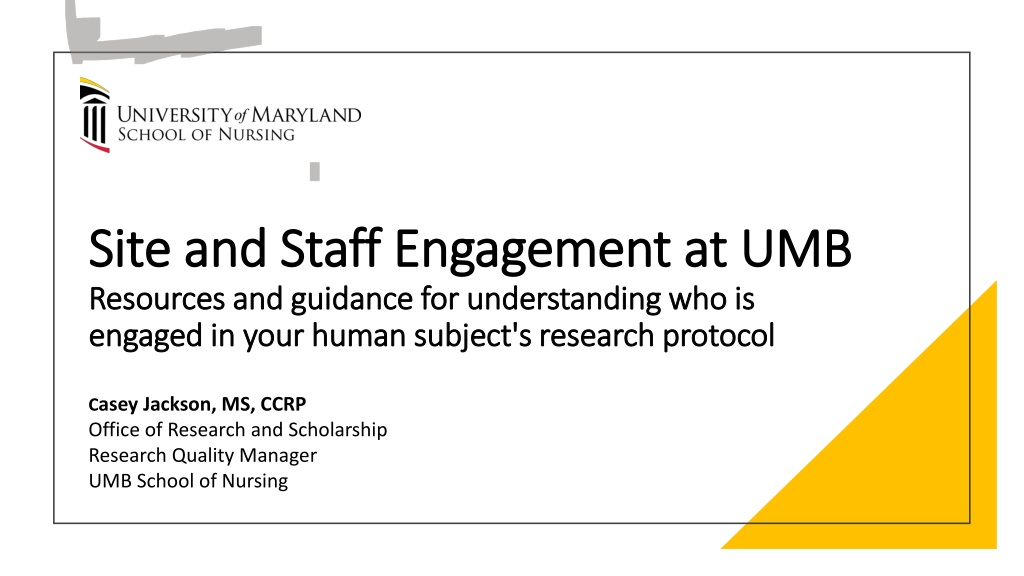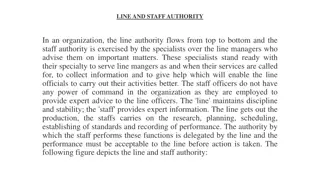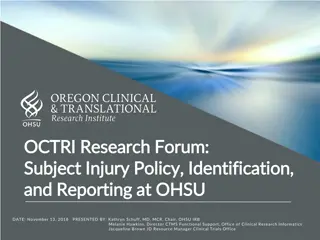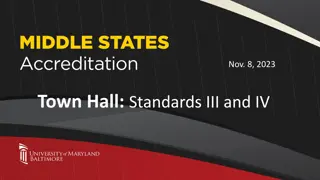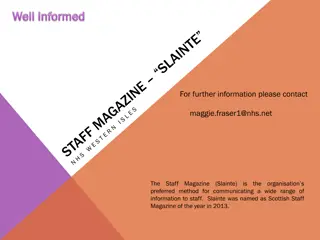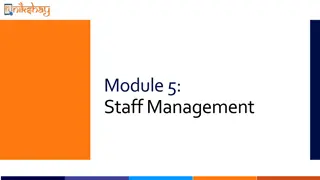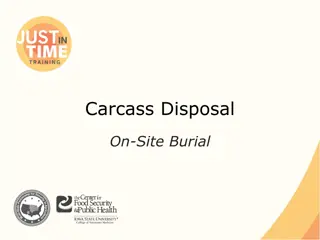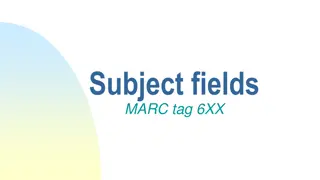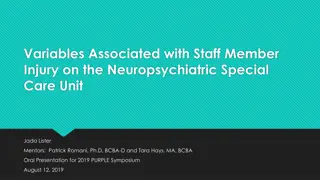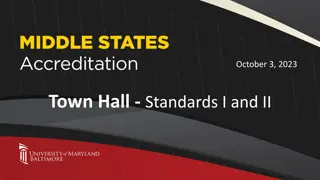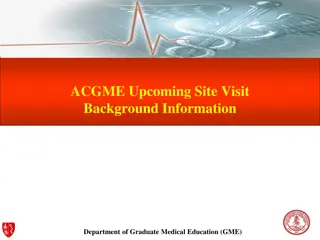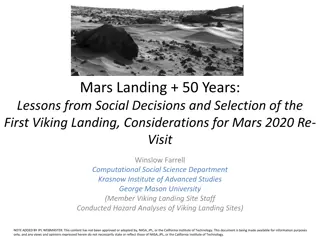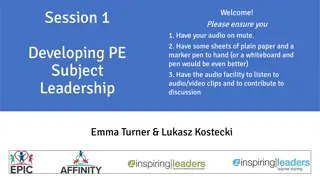Understanding Site and Staff Engagement in Human Subject's Research at UMB
Resources and guidance for identifying individuals engaged in human subject's research protocols, including who should be part of the research team, requirements for Principal Investigators, and determining institutional engagement. Learn from the expertise of UMB professionals and access helpful information for successful research engagement.
Download Presentation

Please find below an Image/Link to download the presentation.
The content on the website is provided AS IS for your information and personal use only. It may not be sold, licensed, or shared on other websites without obtaining consent from the author. Download presentation by click this link. If you encounter any issues during the download, it is possible that the publisher has removed the file from their server.
E N D
Presentation Transcript
Site and Staff Engagement Site and Staff Engagement at UMB Resources and guidance for understanding who is Resources and guidance for understanding who is engaged in your human subject's research protocol engaged in your human subject's research protocol at UMB Casey Jackson, MS, CCRP Office of Research and Scholarship Research Quality Manager UMB School of Nursing
By the end of this seminar, you should be able to: By the end of this seminar, you should be able to: Better understand who would and would not be considered engaged in human subject s research; How to find resources assessing engagement in human subject s research; The implications/requirements for those who are engaged in human subject s research at UMB and UMSON. Provide answers to the quiz at the end of the seminar!
This seminar was created with guidance from the UMB SON, UMB HRPO, the HHS HRPO website, and the UMB Investigator manual (Investigator Manual - Human Research Protections (umaryland.edu) Guidance Guidance The material presented in this seminar may not apply at other institutions. It is recommended that a determination regarding Research Engagement be made by the UMB HRPO through a CICERO application.
Who needs to be added to my human subject s research team in CICERO?!
Who can be a PI? Who can be a PI? Per the UMB HRPO Investigator Manual: To qualify as a principal investigator, you must be a full- time (>51% effort) faculty member holding one of the following titles at UMB: Professor Associate Professor Assistant Professor
When is an When is an institution institution considered engaged? considered engaged? https://www.hhs.gov/ohrp/regulations-and-policy/guidance/guidance-on-engagement-of-institutions/index.html
A. Institutions Engaged in Human Subjects A. Institutions Engaged in Human Subjects Research Research 1) Receive HHS funding 2) Intervene via research procedures 3) Manipulation of the environment 4) Interaction with participants
A. Institutions Engaged in Human Subjects A. Institutions Engaged in Human Subjects Research Research 5) Obtain consent 6) obtain identifiable private information or identifiable biological specimens from any source (observing/recording private behavior, using identifiable data/samples, etc.)* * exceptions
When is an When is an institution institution NOT considered engaged? NOT considered engaged? https://www.hhs.gov/ohrp/regulations-and-policy/guidance/guidance-on-engagement-of-institutions/index.html
B. Institutions Not Engaged in Human B. Institutions Not Engaged in Human Subjects Research Subjects Research 1) Institutions providing commercial services (e.g. transcription service, data capture service, etc.) 2) Institutions providing medical services including private practice (e.g. radiologist, lab phlebotomist)
B. Institutions Not Engaged in Human B. Institutions Not Engaged in Human Subjects Research Subjects Research 3) Institution conducting a research procedure on a one-time or short-term basis* 4) Institutions assisting with recruitment 5) Institutions allowing facility use for outside researchers * Complex determination criteria and requirements
B. Institutions Not Engaged in Human B. Institutions Not Engaged in Human Subjects Research Subjects Research 6) Institutions that release identifiable information or identifiable biospecimens* 7) Institutions that receive coded information or biospecimens without the ability to re-identify* * Complex determination criteria and requirements
B. Institutions Not Engaged in Human B. Institutions Not Engaged in Human Subjects Research Subjects Research 8) Institutions that access identifiers only while visiting the research site for activities under IRB oversight (e.g. study monitors) 9) Institutions that access identifiers for auditing purposes (e.g. Office of Accountability and Compliance, FDA) 10)Institutions receiving identifiable data to satisfy FDA reporting needs 11)Institutions who assist with authoring papers, journal articles, presentations
Exception! Exception! Federally funded research is a whole different ballgame. A site is considered engaged in human subject's research when it receives a direct Federal award to support the research, regardless of the criteria for non-engagement.
Persons Engaged in Human Subjects Research Persons Engaged in Human Subjects Research Study Team member = Someone engaged in a research activity/procedure = Must be listed in UMB IRB application
Persons Engaged in Human Subjects Research Persons Engaged in Human Subjects Research Per HRPO Investigators Manual: Engaged: You are considered engaged when you: 1) intervene or interact with living individuals for research purposes, or 2) obtain individually identifiable private information for research purposes.
Persons Engaged in Human Subjects Research Persons Engaged in Human Subjects Research Per HRPO Investigators Manual: Research Activity: any activity conducted in support of a research protocol aim, done for research purposes outside of the standard of care setting In summary, research team members are engaged when they are assigned by the PI to conduct a research procedure that includes interaction with a participant (virtual or in-person) and/or has access to personal identifiers for protocol specific non- standard of care procedures.
Who can conduct Who can conduct research/research procedures? research/research procedures? Role? CICERO Edit Rights? COI? Research Experience? Knowledge of local sites, culture, society?
CICERO Expectations: UMB HRPO Engaged research team members must have: Active CICERO account Inclusion on approved CICERO application https://www.umaryland.edu/hrp/for-researchers/
Training Expectations: UMB HRPO (UMB affiliates) Trainings: CITI Human Subjects Protections GCP HIPAA 125 HIPAA 201 Other (funding dependent) https://www.umaryland.edu/hrp/for-researchers/required-training/
Training Expectations: UMB IRB under One PI (unaffiliated study team members) One Protocol, Many Sites, One PI, One IRB of Record Provides UMB HRPO with their site required training Site has their own training requirements Provides UMB HRPO with UMB affiliated training Site does not have their own training requirements
Training Expectations: Many PIs/Sites relying on 1 IRB One Protocol, Many Sites/PI s, One IRB of Record Site has their own PI and IRB Provides their IRB with their site required training Site has their own PI and IRB Provides their IRB with their site required training Site has their own PI and IRB Provides their IRB with their site required training
Expectations: ICH GCP 4.1.1 The investigator(s) should be qualified by education, training, and experience to assume responsibility for the proper conduct of the trial, should meet all the qualifications specified by the applicable regulatory requirement(s), and should provide evidence of such qualifications through up-to-date curriculum vitae and/or other relevant documentation requested by the sponsor, the IRB/IEC, and/or the regulatory authority(ies). 4.1.5 The investigator should maintain a list of appropriately qualified persons to whom the investigator has delegated significant trial- related duties.
Unengaged study team members Involved in the research but do not meet engagement criteria -No need to be present in IRB application (when in doubt, ask HRPO first!) -No need for HRPO required trainings* -No need to adhere to GCP expectations * SON still requires GCP for certain unengaged study team members
Publications Do study team members need to be engaged in order to be mentioned in a publication? UMB HRPO: no requirements about listing in publication of de- identified data HHS: study team members can be listed in publication and not be engaged so long as they do not have professional recognition or publication privileges. Other federal agencies: special requirements, consult HRPO Investigators Manual
Scenarios: Test your knowledge! You provide a UMB statistician with your data set, stripped of all identifiers, so that they may assist you with data analysis. Does the statistician need to be added in CICERO (are they engaged)? Yes? No?
Scenarios: Test your knowledge! Your study involves research on lung transplant patients. One of your protocol aims requires data from patient participants routine CT scans. Is the lung transplant unit engaged in the research? Yes? No?
Scenarios: Test your knowledge! You want to recruit community members through a local church. You drop IRB approved fliers off at the church and ask the Pastor if they would hand out the fliers to people in the community who they think may be interested. Is the Pastor engaged? Yes? No? Considerations?
Scenarios: Test your knowledge! During protocol development you collaborate with mentor experts in your field of interest. The mentors assist you with your manuscript by reviewing the aggregate data. Are the mentors engaged? Yes? No?
Scenarios: Test your knowledge! You ask a colleague from University of Washington to take calls from interested study participants in order to assess eligibility and introduce the study. From there the colleague would send the participant to the PI to conduct the consent process. Is the colleague engaged in the research? Yes? No?
Scenarios: Test your knowledge! The quality assurance (QA) assistant comes by to audit your regulatory binder for compliance. There are participant identifiers present in the regulatory binder. Is the QA assistant engaged in the research? Yes? No?
Scenarios: Test your knowledge! You are planning on conducting a chart review of patients at Shock Trauma. One of their doctors has agreed to assist you with obtaining the data from the EMR. Is shock trauma an additional site? - Yes? No? Is the doctor engaged in the research? -Yes? No?
HHS Guidance on Engagement https://www.hhs.gov/ohrp/regulations-and-policy/guidance/guidance- on-engagement-of-institutions/index.html UMB HRPO Investigators Manual https://www.umaryland.edu/hrp/for-researchers/investigator-manual/ Resources Resources UMB HRPO https://www.umaryland.edu/hrp/for-researchers/ UMB SON https://www.nursing.umaryland.edu/research/resources/regulatory- affairs/
Thank You!!! UMB HRPO -Maria Drayton, BS IRB Analyst -Jan Martinez, MS, CIP, CLSSGB IRB Manager
